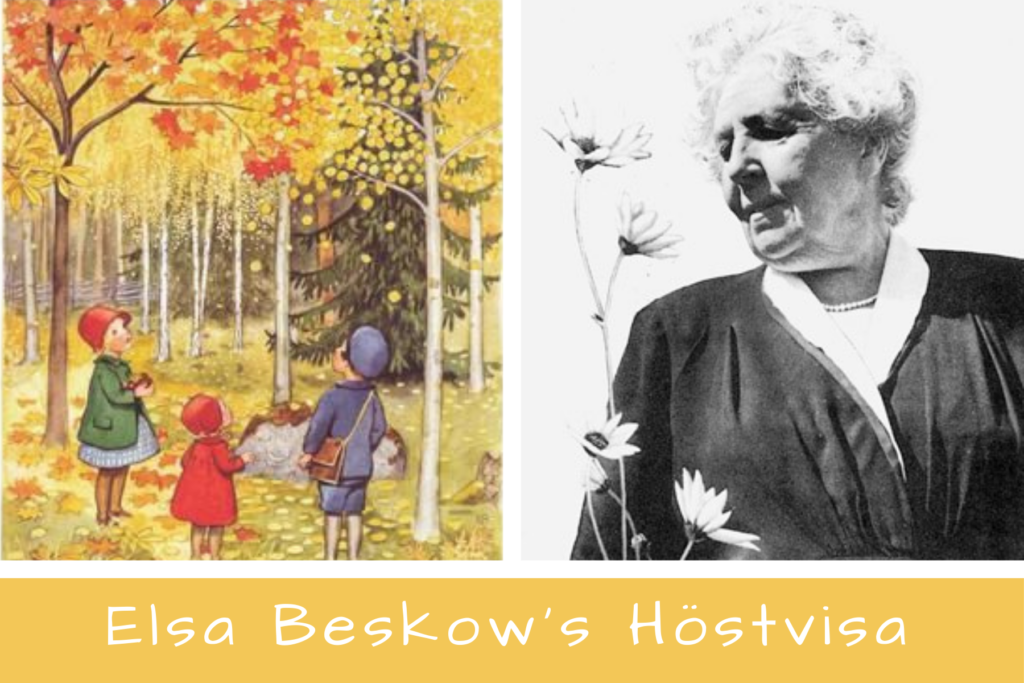Swedish Autumn Vocab with Elsa Beskow’s Höstvisa Posted by Chelsea B on Oct 9, 2020 in Culture, Swedish Language, Vocabulary
“Det glimmar i guld och klaraste rött / It’s glimmering of yellow and the clearest röd.”
It feels as if I’ve landed in Elsa Beskow’s version of autumn as it is in her poem Höstvisa. In Minnesota, the trees are almost glowing with reds, yellows, and oranges, and the light it casts it reminiscent of a fairy tale – enter Elsa Beskow. This week we’ll meet Elsa, and then read her poem Höstvisa.
Beloved children’s book author and illustrator Elsa Beskow (pronounced Beh-skov) was born 1874 in the Stockholm area where she studied eventually studied Art Education at Konstfack, University College of Arts, Crafts and Design. Telling stories from an early age, she had a big imagination. Paired with her love for learning about plants and flowers, they often became main characters in her stories. Her first book was published in 1897 Sagan om den lilla, lilla gumman in English, The Tale of the Little, Little Old Woman, which Beskow adapted from a children’s bedtime story her maternal grandmother told her.
“Tant Grön, Tant Brun och Tant Gredelin,” in English “Aunt Green, Aunt Brown, Aunt Lavender” was another tribute to Beskow’s family. During her youth, she spent quite a bit of time with her extended family, including a slew of aunts and uncles who actually founded a school. Their progressive approach to learning put holistic ideas and experiences in the forefront in a child’s learning, instead of the memorization tactics of the past.
Other famous titles include Olles skidfärd, Hatt-stugan and Tomtebobarnen. Beskow illustrated an A-B-C book and children’s songbook to be used in Swedish classrooms all across the nation. It’s really her illustrations that strike a chord of nostalgia for many Swedes. Her idyllic, pastoral imagery is commonly seen printed on post cards, coffee mugs, and children’s plate sets.
In total, she wrote and illustrated over 40 children’s books containing depictions children meeting fairies, elves, animals that could speak, and other magical woodland creatures. Beskow was known for her curiosity in exploring the fantastical in nature and creating a space for other’s to do so as well. Her legacy lives on with the Elsa Beskow Award. Created in 1958, it recognizes Sweden’s best picture book illustrator of the year.
So dig in, and let you imagination take hold with Elsa Beskow’s Höstvisa.
Det glimmar i guld och klaraste rött,
det prasslar så sakta i parken,
ty hösten är kommen, och björkar och lönn
de fäller nu bladen till marken:
“Så fall, våra blad, fall mjukt och lätt,
vi väver ett täcke så varmt och så tätt,
vi väver sitt täcke åt marken.
Se vintern är nära, och vädret är grått,
nu måste vi värma och lysa!
Vi väver ett täcke så varmt och så gott,
att blombarnen icke må frysa.
Sov gott, alla blombarn, sov gott, sov sött,
vi väver ett täcke i guld och i rött,
vi väver ett täcke åt marken.”

Build vocabulary, practice pronunciation, and more with Transparent Language Online. Available anytime, anywhere, on any device.







Comments:
Jan V H Luthman:
“Det glimmar i guld och klaraste rött
Just one tiny suggestion.
To retain the original metre of Höstvisa, perhaps the English first line could be rephrased slightly:
It glimmers in gold and clearest of reds